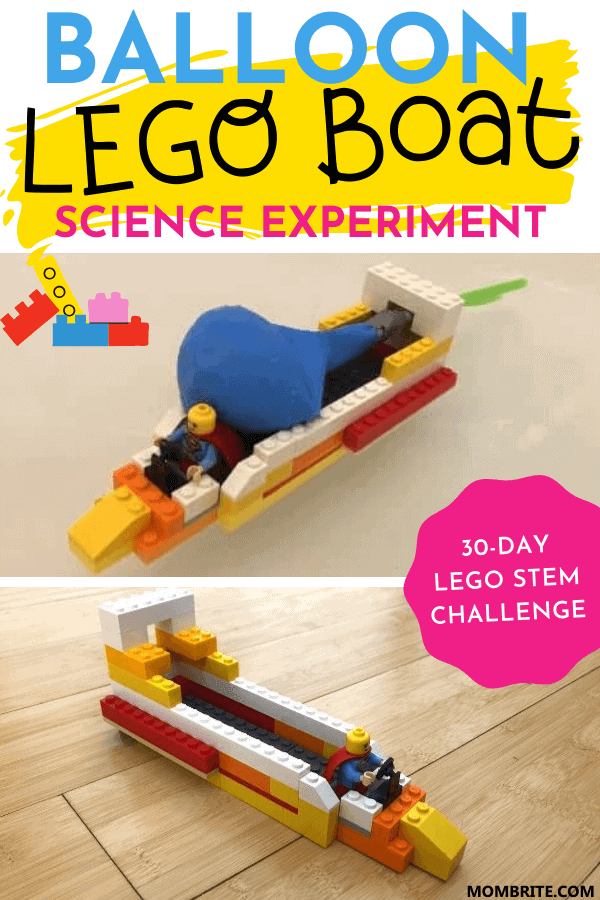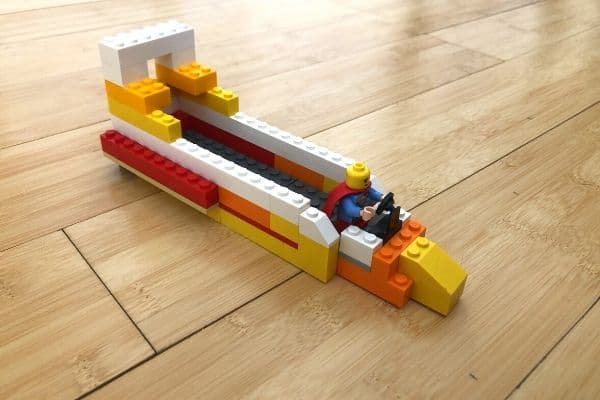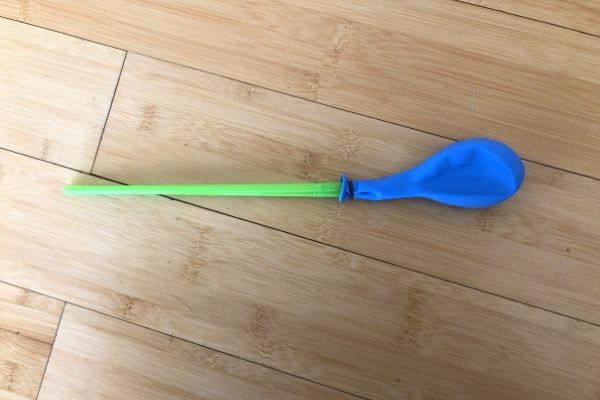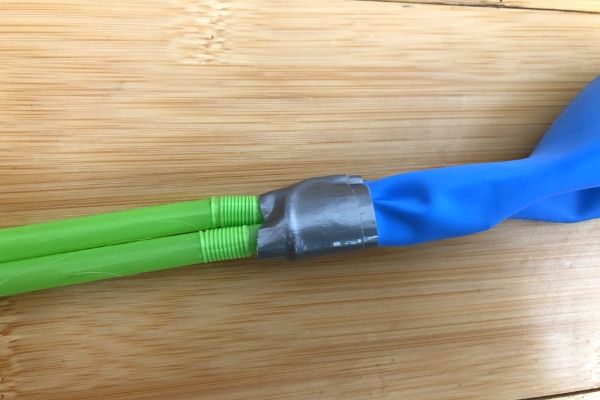These balloon-powered LEGO boats are so fun to design and create. Your kids will love watching the bubbles push the LEGO boat around the water!
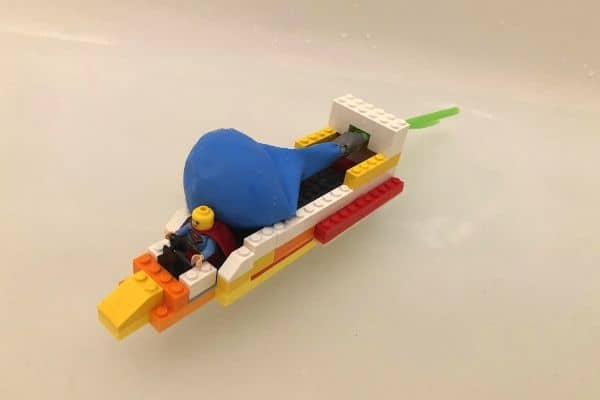
Okay, so I had this crazy idea.
If you can make a LEGO car move with the air from a balloon, why can’t you do the same with a boat?
And the balloon-powered LEGO boat was born!
You may be skeptical whether or not a blown-up balloon really could move a boat across water. It is more difficult to figure this one out than the balloon-powered LEGO cars, but after trying different designs and ways of attaching the balloon, we got it to work.
I am going to show you the 3 options we tried when trying to get the boat to move with a balloon. I will also discuss what is the easiest option and the one that worked the best. You can see all 3 options in action in the video below.
Find out how to make your own balloon-powered LEGO boat below!
How to Build a Balloon-Powered LEGO Boat
Materials:
- LEGO bricks
- Balloons
- Water
- A large container (or you can use the bathtub)
- Optional: 2 drinking straws, rubber band, duct tape
- Optional: 1 large Boba tea straw
Instructions:
- Fill a container (or a bathtub) with water.
- Build a LEGO boat that floats. This may be challenging itself. We find that making the base with the taller bricks (instead of a plate) and having less weight on top will do the trick.
- Make a small hole on the boat with the LEGO bricks to hold the balloon in place.
Option 1:
- Stick the balloon through the hole with the lip of the balloon facing the back of the boat.
- Blow up the balloon (not too big!) and hold the end shut while you place the boat on the water.
- Let go of the balloon and watch the LEGO boat propel forward!
Option 2:
- Stick two drinking straws in the balloon.
- Secure the balloons with a small rubber band.
- To ensure no air escapes, use duct tape around the rubber band area and secure the balloon to the drinking straws.
- Stick the drinking straws through the hole in the LEGO boat.
- Adjust the straws so the bottom of the straws is just a little higher than the bottom of the boat. You may need to cut the straws shorter.
- Blow up the balloon and hold the end shut while you place the boat in the water.
- Let go and watch the LEGO boat move across the water.
Option 3:
- Similar to Option 2, but use a thicker Boba tea straw instead of the 2 drinking straws.
For us, the designing of the LEGO boat that floats wasn’t too difficult. We learned from the balloon-powered LEGO car activity that the boat needs to be long. This gives room for the balloon as you blow it up or else the balloon will be breaking off the bricks of your boat. This also helps the boat stay straight instead of turning.
Which design worked the best for you? For us, Option 2 with the drinking straws worked the best for our LEGO boats. It allowed the air to escape slowly out of the balloon and even though it didn’t have as much thrust as the other boats did with just the balloon or the thick straw, it pushed the boat along more consistently. We did have an issue with the boat not going straight and the boat running into the side of the bathtub, or else I believe the boat would have gone farther.
Option 3 with the Boba tea straw worked better than having no straw at all. The straw was able to focus the air into one stream and direct the air to propel the LEGO boat directly forward.
Unlike the LEGO cars, the balloon had a lot more trouble staying in place. This is because we are dealing with the water’s resistance now, whereas before the LEGO car had wheels and could move with very little resistance on the flat, wooden floor.
Let’s discuss more about the force of water below.
The Science Behind the LEGO Balloon Boat
Similar to what we explored in the LEGO balloon car, Newton’s laws are at work here.
The release of the air from the balloon exerts a force on the boat and pushes it forward.
However, there is more at play here. As the boat moves through the water, the boat experiences a force acting opposite to its direction of motion. This force is the water’s resistance to the boat. It’s similar to the friction the LEGO car experiences from the floor, but the cars have wheels that can roll along the floor.
As the boat moves ahead, the water is parted to allow the hull to move through it. Bodies moving in fluids slow down because of resistive forces known as drag. Drag acts opposite to the relative motion of the boat with respect to the water.
Because of drag, you might experience the balloon detaching from the boat when you let it go. This is because the force of the air from the balloon is not large enough to overcome the water resistance and move the entire boat. There is also very little friction between the balloon and the boat to hold the balloon in place. As a result, the balloon flies off, leaving the boat in the water unmoved.
To combat the drag, you can do a couple of things. You can adhere the balloon to the boat so that it doesn’t fly away, or in our case, we made the hole smaller.
The drag is also why letting the air out of the balloon slowly by attaching two drinking straws to it makes the boat go farther. Imagine a giant, heavy box on the floor. Due to the mass of the box, there is a lot of friction between the floor and the box.
Imagine you are trying to push the box along the floor. If you take a running start and ram the box with your body, will the box move? Maybe, but not much. But if you push the box and try and move it slowly and with a steady force, then the box will continue to move until you stop pushing.
Similarly, when we use just the balloon and even the balloon with the large Boba tea straw, the boat gets one large initial thrust but that’s it. The air escapes quickly and the boat is left with no additional force on it and just floats in the direction it was pushed.
When we use the two smaller drinking straws, air escapes slowly and pushes the boat steadily along the water. This allows the boat to move farther than the other two options.
And of course, when we are talking about boats and water, we need to also explore the concept of buoyancy. Understanding buoyancy will affect the design of your boat and why the boat can’t be too heavy on the top. We discussed buoyancy in detail with the penny LEGO boat challenge, so you can check out the explanations here.
Final Thoughts on the Balloon LEGO Boats
Building a LEGO boat that floats is part of the 30-day LEGO challenge. Making it move with a balloon is an extra bonus!
If your kid is a LEGO fan and likes LEGO STEM challenges, make sure to grab your calendar below:
